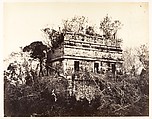La Prison, à Chichen-Itza
Désiré Charnay French
Not on view
Charnay was among the first to photograph Mexico's stunning Mayan ruins. The French archaeologist-adventurer gained considerable fame with the publication of his photographs and an account of his travels entitled Cités et ruines américaines: Mitla, Palenqué, Izamal, Chichen-Itza, Uxmal (1862-63). In this plate from the album, Charnay photographed a building he described as a "prison" emerging from the jungle at Chichén-Itzá. Built in the late eighth or ninth century, this temple building was constructed in a complex architectural style called Puuk and is today known as the Casa Colorada or Chichen Chob. Archaeologists are unsure of the structure's original function, but most today believe the building may have been an elite residence. Without the advantages of modern carbon dating and years of scholarly analysis, Charnay simply documented the overgrown site and endowed it with all the mystery and enchantment of one's childhood fantasy of lost paradise.
This image cannot be enlarged, viewed at full screen, or downloaded.


